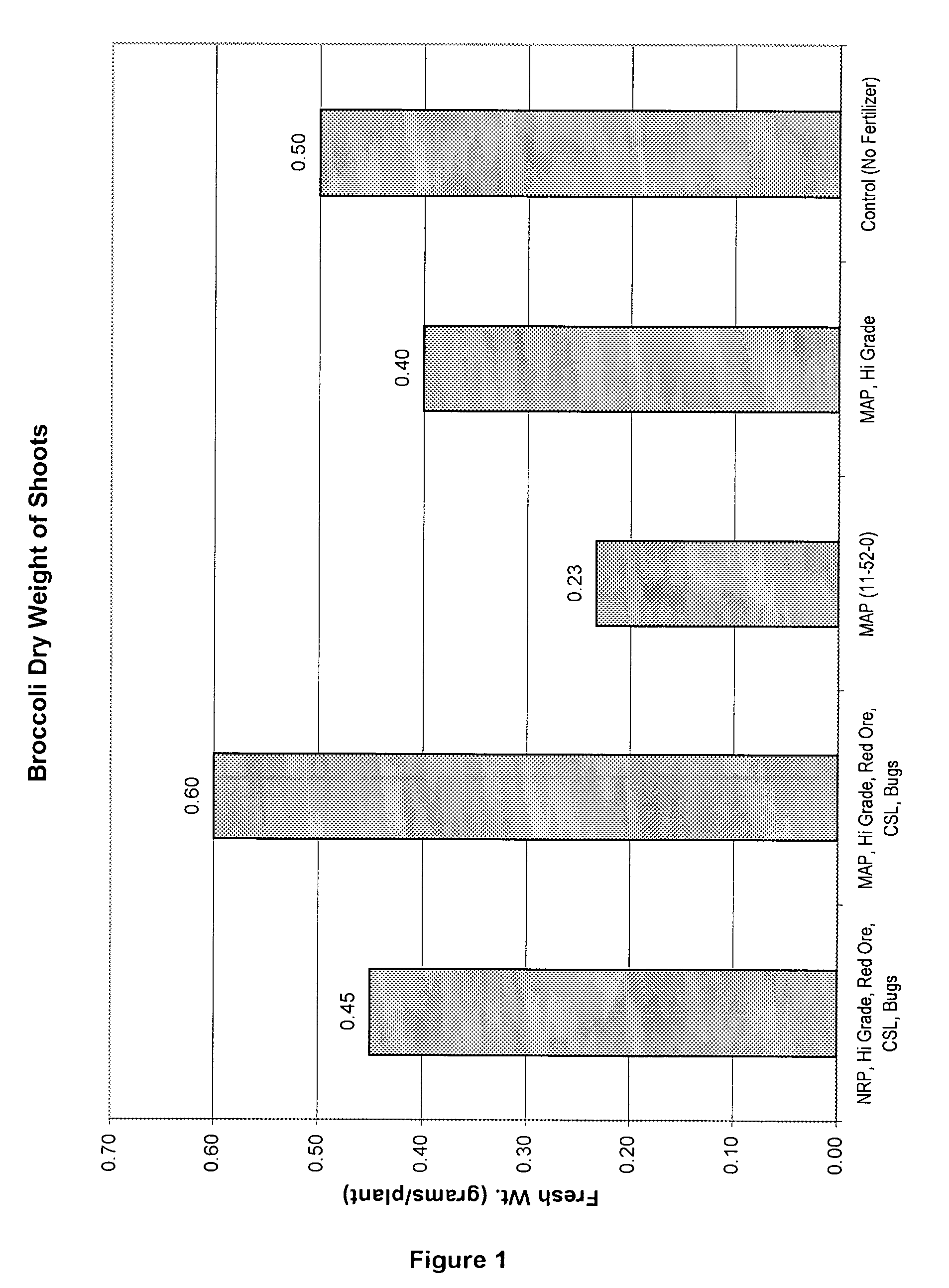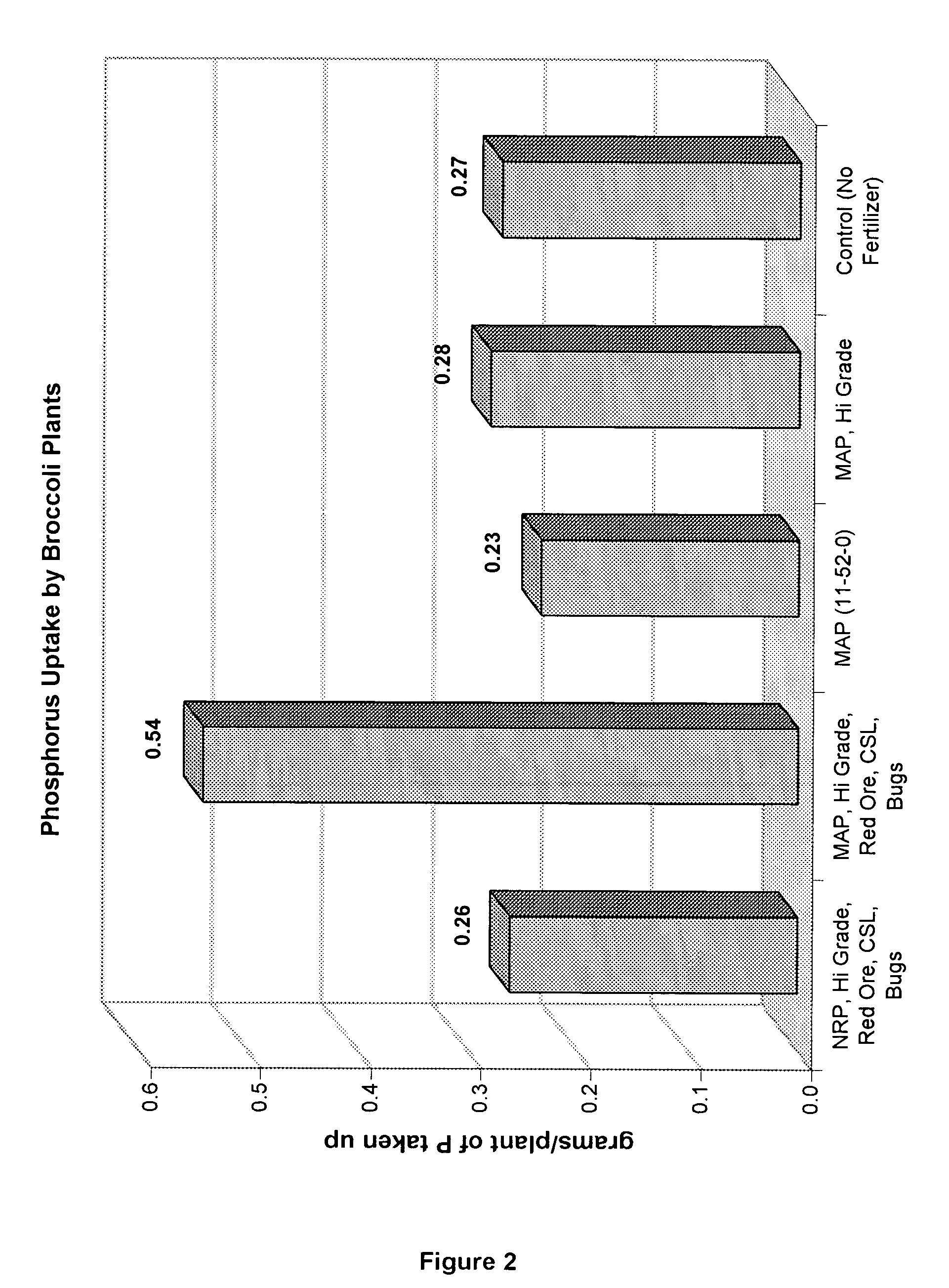Phosphate replacement fertilizers
a technology of fertilizer and phosphate, applied in the field of fertilizer products, can solve problems such as inability to absorb
- Summary
- Abstract
- Description
- Claims
- Application Information
AI Technical Summary
Benefits of technology
Problems solved by technology
Method used
Image
Examples
example 1
Exemplary Process for Making Fertilizer Composition
Initially, 430.3 kilograms (950 pounds) of pulverized Leonardite (equivalent to about 301.2 kilograms humic acid) is blended with 430.3 kilograms (950 pounds) of finely ground rock phosphate, 36.3 kilograms (80 pounds) of pulverized iron ore, 8.6 kilograms (19 pounds) of molasses, and 0.45 kilograms (1 pound) of microorganism inoculant in a ribbon or paddle blender. The mixture still feels dry to the touch with this amount of moisture from the binding agent. After thorough blending, the mixture is fed into the hopper of a force feed screw type feed system. This forces the mixture between the two rollers of the compaction briquetter at up to 211 kilogram-force per square centimeter (3000 pounds per square inch) of pressure creating a sheet of combined product. This sheet drops through a “granulator” that basically looks like the tines of a rototiller, and the granulator breaks the sheet into particles. The design and speed of these...
example 2
Application of Fertilizer Composition to Stone Fruit Trees
In 1999, a trial was conducted in Reedley Calif. on stone fruit trees to test the effectiveness of a fertilizer composition of the present invention for phosphate response.
The test formulation was: 47.9% Leonardite by weight of final product (equivalent to 33.5% humic acid) by weight of final product; 47.9% natural rock phosphate by weight of final product; 4.0% iron oxide ore by weight of final product; 0.1% zinc, copper and boron micronutrient blend by weight of final product; and 0.1% xanthium gum by weight of final product. The ingredients were mixed in a slurry, and band applied to the shoulder of the berm alongside the tree base. Tissue tests were evaluated for uptake of phosphate compared to historical data, and an increase in phosphate levels in the fruit tree tissue tests was noted. Soil samples were analyzed, and an increase in available phosphate in the soil in the treated area was noted compared to historical ...
example 3
Application of Fertilizer Composition to Broccoli
A trial was conducted at the Fisher Greenhouse in Ripon, Calif. to test the effectiveness of a fertilizer composition of the present invention for phosphate response in broccoli plants grown in pots filled with a non-saline, calcareous soil with a moderate phosphate level.
Several treatments and controls were included in the trial, and each treatment group contained seven broccoli plants: Treatment Group 1B (mix amount in grams per pot): 0.9 grams natural rock phosphate, 0.9 grams high grade Leonardite ore, 0.18 grams red ore (iron ore), 9 milliliters carbohydrate-containing binding agent, and 0.4 grams bacterial inoculant; Treatment Group 2B (mix amount in grams per pot): 0.9 grams monoammonium phosphate (MAP), 0.9 grams high grade Leonardite ore, 0.18 grams red ore (iron ore), 9 milliliters carbohydrate-containing binding agent, and 0.4 grams bacterial inoculant; Treatment Group 3B (mix amount in grams per pot): 0.9 grams MAP ...
PUM
| Property | Measurement | Unit |
|---|---|---|
| pressure | aaaaa | aaaaa |
| pressure | aaaaa | aaaaa |
| weight | aaaaa | aaaaa |
Abstract
Description
Claims
Application Information
 Login to View More
Login to View More - R&D
- Intellectual Property
- Life Sciences
- Materials
- Tech Scout
- Unparalleled Data Quality
- Higher Quality Content
- 60% Fewer Hallucinations
Browse by: Latest US Patents, China's latest patents, Technical Efficacy Thesaurus, Application Domain, Technology Topic, Popular Technical Reports.
© 2025 PatSnap. All rights reserved.Legal|Privacy policy|Modern Slavery Act Transparency Statement|Sitemap|About US| Contact US: help@patsnap.com


